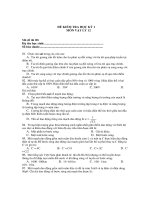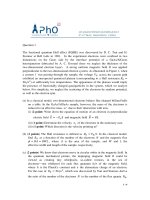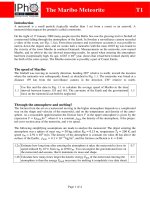Đề thi WoPhO 2012 Bài 1 môn vật lý
Bạn đang xem bản rút gọn của tài liệu. Xem và tải ngay bản đầy đủ của tài liệu tại đây (498.36 KB, 4 trang )
Problem Creator: Viktor Ivanov
Theoretical 1: Magnetic Monopole
1 Introduction
Our everyday experience shows that the magnetic poles always exist in pairs North and South.
Breaking a magnet results in the appearance of a new pair of opposite magnetic poles on the
two broken ends. The fundamental laws of physics, however, do not contradict the existence of
magnetically charged particles called magnetic monopoles. The magnetic monopole is an object
possessing just one magnetic pole, either North, or South, which are analogues of the positive
and negative electric charges respectively. Thus, the magnetic field of the monopole is similar
to the electric field created by a static electric charge, i.e. its force lines begin or end at the
point where the monopole is located. This property is in contrast to the closed force lines of the
magnetic field created by permanent magnets (magnetic dipoles) and electric currents. The concept
of magnetic monopole was introduced in 1932 by the famous physicist Paul Dirac. On the basis of
quantum mechanics he proved that the existence of magnetic monopoles can explain the existence
of the elementary electric charge. That is why the physicists do not cease their efforts to discover
magnetic monopoles experimentally.
In the following questions you are going to establish some properties of the magnetic monopoles
by analyzing simple model situations (though experiments). You may assume that all laws of
physics known to you apply to the magnetic monopoles, except the statement for closed force lines
of the magnetic field. The velocities considered in this problem are much smaller than the speed
of light and, therefore, you may neglect the relativistic effects on time, length and mass.
Use the following physical constants in your solution:
magnetic permeability of vacuum: µ
0
= 4π × 10
−7
H/m ;
electric permittivity of vacuum:
0
= 8.85 × 10
−12
F/m ;
speed of light: c = 2.998 × 10
8
m/s ;
elementary electric charge: e = 1.602 × 10
−19
C ;
Planks constant: h = 6.626 × 10
−34
J.s .
2 Questions
1. When exposed to external magnetic field of induction B, a monopole of magnetic charge q
m
experiences a force:
F = q
m
B (1)
(a) Derive the unit of magnetic charge in terms of the basic SI units: kilogram, meter, second,
ampere. (0.8 points)
Magnetic Monopole Page 1 of 4
Problem Creator: Viktor Ivanov
Theoretical 1: Magnetic Monopole
2. Electric current I circulates along a circular loop of radius a. A monopole of magnetic charge
q
m
is situated on the axis of the loop at a point of coordinate z relative to its center, as shown
in Figure 1 . The positive direction of the axis Z and the direction of current circulation are
related through the right-hand rule.
(a) Find out an expression for the z-component F
z
of the force acting on the monopole.
(1.1 points)
4
Questions
Question 1. When exposed to external magnetic field of induction B, a monopole of magnetic
charge
q
m
experiences a force:
BF
m
q
a. Derive the unit of magnetic charge in terms of the basic SI units: kilogram, meter, second,
ampere.
Question 2. Electric current I circulates along a circular loop of radius a. A monopole of
magnetic charge
q
m
is situated on the axis of the loop at a point of coordinate z relative to its
center, as shown in Figure 1. The positive direction of the axis
Z and the direction of current
circulation are related through the right-hand rule.
a. Find out an expression for the z-component F
z
of the force acting on the monopole.
Figure 1.
Question 3.
When at rest, the magnetic monopole creates static magnetic field, similar to the
electric field produced by a static electric charge. The magnetic induction
B at a point of position-
vector
r, relative to the monopole (see Figure 2), is given by the equation:
3
r
qk
mm
r
B
where
k
m
is a coefficient of proportionality and
r
r
. Figure 2.
a.
By analyzing the system described in Question 2, express the unknown coefficient k
m
through the provided fundamental constants.
b. Formulate by means of equation the Gauss law for the flux of the magnetic induction
created by the magnetic monopole.
Question 4. A moving electric charge creates magnetic field. Likewise, the moving magnetic
monopole produces electric field with circular force-lines (i.e. a vortex field) concentric with the
direction of motion of the monopole (see Figure 3). Consider a monopole of magnetic charge
q
m
moving along a straight line with a constant velocity
v.
Z
q
m
I
a
q
m
r
B
Figure 1: Question 2
3. When at rest, the magnetic monopole creates static magnetic field, similar to the electric field
produced by a static electric charge. The magnetic induction B at a point of position- vector
r, relative to the monopole (see Figure 2), is given by the equation:
B =
k
m
q
m
r
r
3
, (2)
where k
m
is a coefficient of proportionality and r = |r|.
4
Questions
Question 1. When exposed to external magnetic field of induction B, a monopole of magnetic
charge
q
m
experiences a force:
BF
m
q
a. Derive the unit of magnetic charge in terms of the basic SI units: kilogram, meter, second,
ampere.
Question 2. Electric current I circulates along a circular loop of radius a. A monopole of
magnetic charge
q
m
is situated on the axis of the loop at a point of coordinate z relative to its
center, as shown in Figure 1. The positive direction of the axis
Z and the direction of current
circulation are related through the right-hand rule.
a. Find out an expression for the z-component F
z
of the force acting on the monopole.
Figure 1.
Question 3.
When at rest, the magnetic monopole creates static magnetic field, similar to the
electric field produced by a static electric charge. The magnetic induction
B at a point of position-
vector
r, relative to the monopole (see Figure 2), is given by the equation:
3
r
qk
mm
r
B
where
k
m
is a coefficient of proportionality and
r
r
. Figure 2.
a.
By analyzing the system described in Question 2, express the unknown coefficient k
m
through the provided fundamental constants.
b. Formulate by means of equation the Gauss law for the flux of the magnetic induction
created by the magnetic monopole.
Question 4. A moving electric charge creates magnetic field. Likewise, the moving magnetic
monopole produces electric field with circular force-lines (i.e. a vortex field) concentric with the
direction of motion of the monopole (see Figure 3). Consider a monopole of magnetic charge
q
m
moving along a straight line with a constant velocity
v.
Z
q
m
I
a
q
m
r
B
Figure 2: Question 3
(a) By analyzing the system described in Question 2, express the unknown coefficient k
m
through the provided fundamental constants. (1.6 points)
(b) Formulate by means of equation the Gauss law for the flux Φ of the magnetic induction
created by the magnetic monopole. (0.5 points)
4. A moving electric charge creates magnetic field. Likewise, the moving magnetic monopole
produces electric field with circular force-lines (i.e. a vortex field) concentric with the direction
of motion of the monopole (see Figure 3). Consider a monopole of magnetic charge q
m
moving
along a straight line with a constant velocity v.
Magnetic Monopole Page 2 of 4
Problem Creator: Viktor Ivanov
Theoretical 1: Magnetic Monopole
5
a. Derive an expression for the intensity E of the electric field created by the monopole in a
point of position-vector
r making an angle with the vector of velocity, as shown in
Figure 3. Use vector notations in your final answer in order to specify both, the
magnitude, and the direction of the electric field.
b. Suppose that a positive electric charge q
e
and a positive magnetic charge q
m
are moving
against you, perpendicularly to the sheet of paper. Draw two arbitrary force lines in your
answer sheet – one for the magnetic field created by the electric charge and another, for
the electric field created by the magnetic monopole. Indicate the directions of the two
lines.
Question 5. The analogy between electric and magnetic charges is found also in the way they
interact with external magnetic and electric fields respectively. Similarly to the Lorentz force
acting on an electric charge moving in magnetic field, the magnetic charge experiences a force
when it moves in electric field.
a. Propose and analyze a thought experiment in order to derive an expression for the
“Lorenz” force acting on a monopole of magnetic charge
q
m
moving with a velocity v in
electric field of intensity
E. Use vector notations in your final answer in order to specify
both, the magnitude and the direction of the force. When describing your thought
experiment, use proper drawings and short comments to them instead of a lengthy text.
Question 6. A point particle of electric charge q
e
is confined to move along a circle without any
resistance or friction, as shown in Figure 4. A monopole of magnetic charge
q
m
passes through
the plane of the circle by moving along its axis
Z from
z to
z
.
Figure 4.
Z
q
m
q
e
Figure 3.
q
m
r
v
electric force line
Figure 3: Question 4
(a) Derive an expression for the intensity E of the electric field created by the monopole in a
point of position-vector r making an angle θ with the vector of velocity, as shown in Figure
3. Use vector notations in your final answer in order to specify both, the magnitude, and
the direction of the electric field. (1.7 points)
(b) Suppose that a positive electric charge q
e
and a positive magnetic charge q
m
are mov-
ing toward you, perpendicularly to the sheet of paper. Draw an arbitrary force line
in your answer sheet for the magnetic field created by the electric charge. Draw sepa-
rately another arbitrary force line for the electric field created by the magnetic charge.
Indicate the directions of the two lines. (0.4 points)
5. The analogy between electric and magnetic charges is found also in the way they interact with
external magnetic and electric fields respectively. Similarly to the Lorentz force acting on an
electric charge moving in magnetic field, the magnetic charge experiences a force when it moves
in electric field.
(a) Propose and analyze a thought experiment in order to derive an expression for the Lorentz
force acting on a monopole of magnetic charge q
m
moving with a velocity v in electric
field of intensity E. Use vector notations in your final answer in order to specify both, the
magnitude and the direction of the force. When describing your thought experiment, use
proper drawings and short comments to them instead of a lengthy text. (1.0 points)
6. A point particle of electric charge q
e
is confined to move along a circle without any resistance
or friction, as shown in Figure 4. A monopole of magnetic charge q
m
passes through the plane
of the circle by moving along its axis Z from z → −∞ to z → ∞.
Figure 4: Question 6
Magnetic Monopole Page 3 of 4
Problem Creator: Viktor Ivanov
Theoretical 1: Magnetic Monopole
(a) Obtain an expression for the change in Zcomponent, ∆L
z
, of the angular momentum
of the electrically charged particle during the whole motion of the magnetic monopole.
Express your answer in terms of q
e
, q
m
and fundamental constants only. (1.3 points)
7. In his famous work on magnetic monopoles Paul Dirac has argued that if just one magnetic
monopole existed in the Universe, all electric charges should be multiple of a specific elementary
electric charge, whose magnitude is related to the magnetic charge of that monopole. Histori-
cally, it is the first hypothesis in physics, which explains the existence of the elementary electric
charge.
Consider the system described in Question 6, assuming that all magnetic monopoles existing
in the Nature have magnetic charges of the same magnitude, +q
m
and −q
m
respectively.
(a) By applying the concepts of quantum physics to the motion of electrically charged particle
along the circular orbit, derive a relationship between the elementary electric charge e,
assumed to be the charge of the electron, and the magnetic charge q
m
of the monopole.
Calculate q
m
numerically. (1.1 points)
(b) The electron possesses a self magnetic moment of p
m
= 9.274 × 10
−24
A.m
2
. By assuming
that the magnetic properties of the electron are due to a pair of spatially separated point
magnetic monopoles of opposite magnetic charges, +q
m
and −q
m
respectively; calculate
the distance d between these monopoles. (0.5 points)
Useful math :
• The solid angle Ω enclosed by a cone of half-opening angle θ (see the Figure 5) is: Ω =
2π(1 − cos(θ))
6
a. Obtain an expression for the change in Z–component, L
z
, of the angular momentum of
the electrically charged particle during the whole motion of the magnetic monopole.
Express your answer in terms of
q
e
, q
m
and fundamental constants only.
Question 7. In his famous work on magnetic monopoles Paul Dirac has argued that if just one
single magnetic monopole existed in the Universe, all electric charges should be multiple of a
specific elementary electric charge, whose magnitude is related to the magnetic charge of that
monopole. Historically, it is the first hypothesis in physics, which explains the existence of the
elementary electric charge.
Consider the system described in Question 6, assuming that all magnetic monopoles existing in
the Nature have magnetic charges of the same magnitude, +
q
m
and –q
m
respectively
.
a. By applying the concepts of quantum physics to the motion of electrically charged
particle along the circular orbit, derive a relationship between the elementary electric
charge
e, assumed to be the charge of the electron, and the magnetic charge q
m
of the
monopole. Calculate
q
m
numerically.
b. The electron possesses a self magnetic moment of
224
A.m102749
.
m
p . By assuming
that the magnetic properties of the electron are due to a pair of spatially separated point
magnetic monopoles of opposite magnetic charges, +
q
m
and –q
m
respectively; calculate the
distance
d between these monopoles.
Useful math:
The solid angle enclosed by a cone of half-opening angle (see the figure) is:
))cos((
12
Depending on your approach to the solution you may need the following integral:
22322
2d
aaz
)(
z
Figure 5: Solid Angle
• Depending on your approach to the solution you may need the following integral:
∞
−∞
dz
(z
2
+ a
2
)
3/2
=
2
a
2
. (3)
Magnetic Monopole Page 4 of 4









